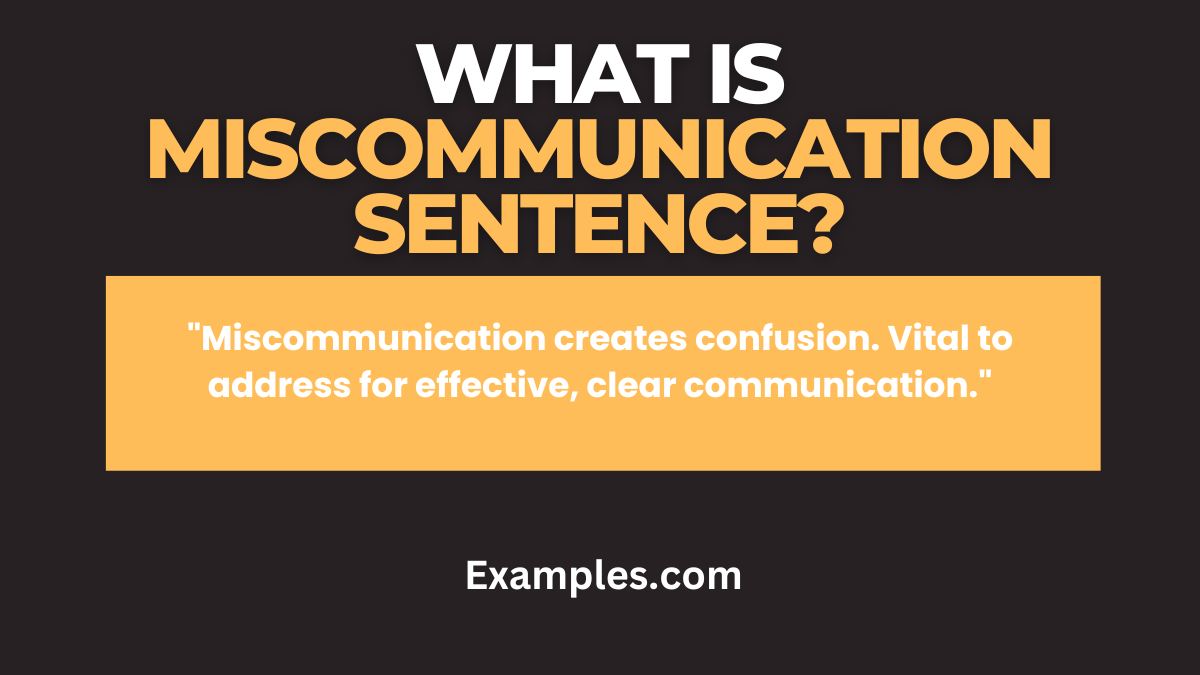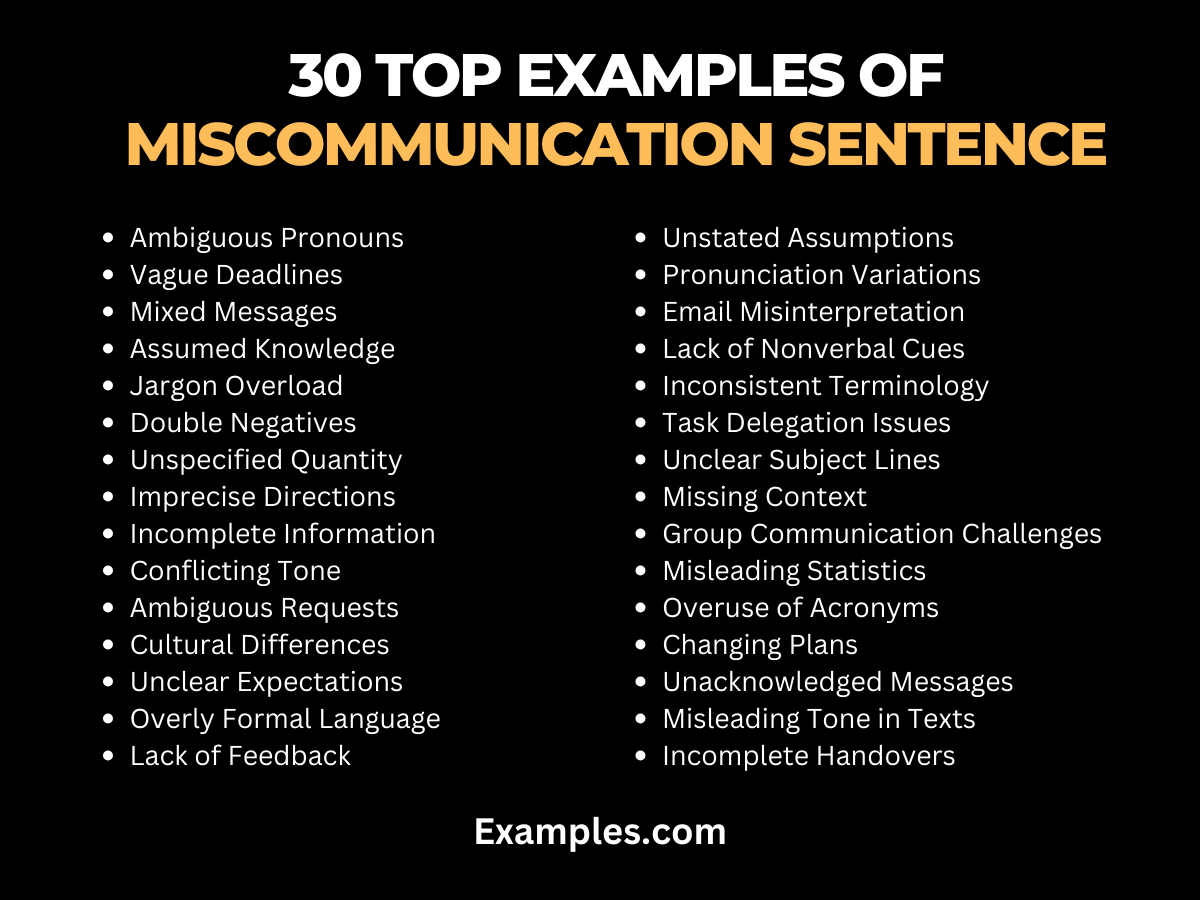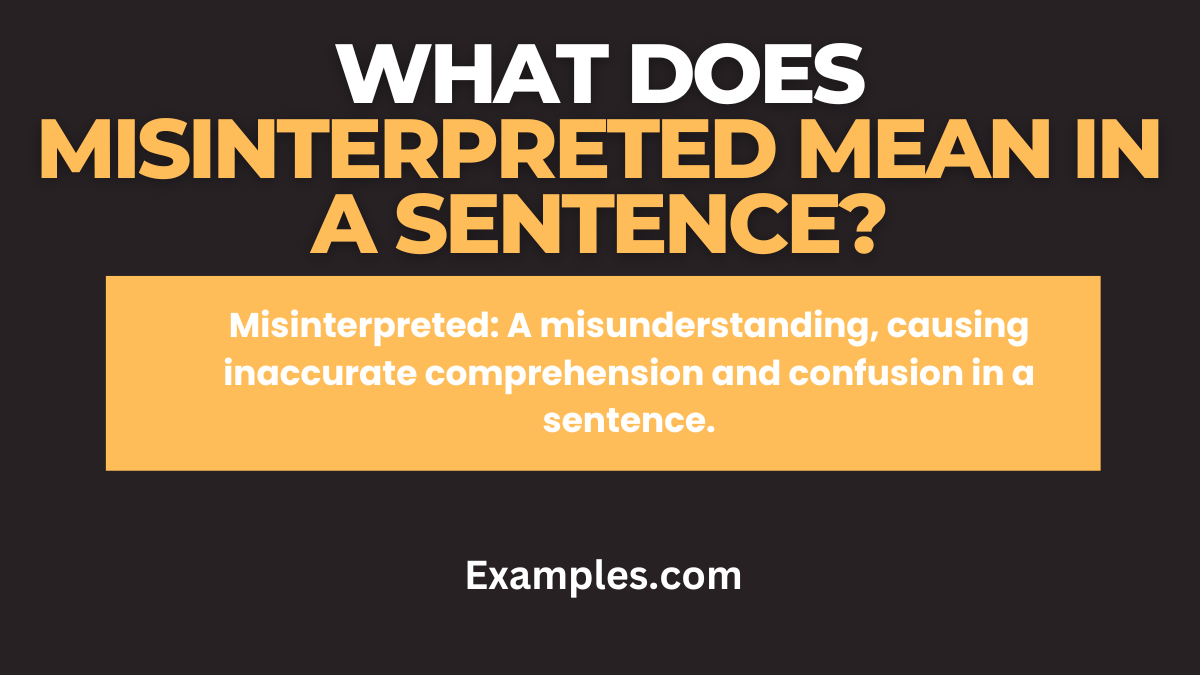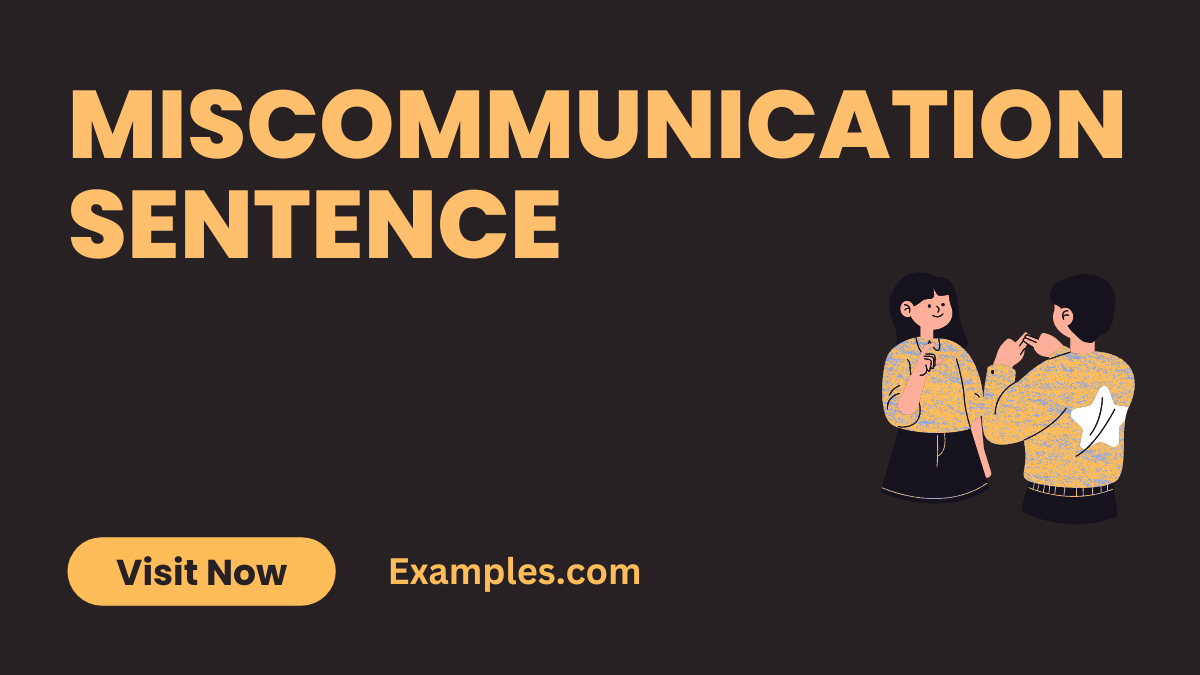Miscommunication Sentence
In the intricate web of human interaction, effective communication stands as the cornerstone, rendering the lack of miscommunication a paramount goal. Navigating through the nuances of conveying thoughts and ideas, this comprehensive guide explores strategies and examples to obliterate communication barriers. Uncover the art of precision in expression, honing your skills to foster clarity and understanding. Delve into insightful “Communication Examples” to illuminate the path towards seamless and error-free interaction, empowering you to master the language of effective communication.
What is Miscommunication Sentence?

A “Miscommunication Sentence” refers to a statement or message that is unclear, confusing, or open to misinterpretation. In simple terms, it represents a breakdown in communication where the intended meaning is not accurately conveyed, leading to confusion or misunderstanding. Miscommunication sentences can arise from various factors, such as ambiguous language, poor articulation, or differences in perception. Recognizing and addressing miscommunication is crucial for effective communication, as it helps prevent misunderstandings and ensures that information is accurately transmitted between individuals or parties.
What is the best Example of Miscommunication Sentence?
Consider the scenario where someone instructs a colleague to “leave the document on my desk by noon.” If the colleague interprets this as a request to submit the document exactly at noon, while the speaker meant to convey the deadline of before noon, a miscommunication arises. The ambiguity in the instruction, particularly regarding the timing of the task, leads to confusion and potentially missed expectations. This example highlights how unclear directives can result in misinterpretation, emphasizing the importance of precise communication to avoid such instances.
30 Top Examples of Miscommunication Sentence

In the intricate dance of language, miscommunication sentences frequently emerge, weaving webs of confusion. These instances stem from various sources, be it ambiguous wording, incomplete information, or differing interpretations. Explore an array of examples showcasing the pitfalls and intricacies of communication, shedding light on the nuances often overlooked.
- Ambiguous Pronouns:
Example: “He gave her the book after reading it.”
Cause: Unclear reference of pronouns. Solution: Specify subjects for clarity. - Vague Deadlines:
Example: “Submit the report soon.” Cause: Lack of a specific timeframe.
Solution: Define a clear deadline. - Mixed Messages:
Example: “I’m fine with any decision, but I have reservations.”
Cause: Contradictory statements. Solution: Provide a consistent stance. - Assumed Knowledge:
Example: “Meet me at the usual place.”
Cause: Assumes shared knowledge. Solution: Specify the location. - Jargon Overload:
Example: “Optimize the UI for better UX.”
Cause: Technical terms may be unclear. Solution: Define acronyms and terms. - Double Negatives:
Example: “I don’t want nothing to do with it.”
Cause: Double negatives create confusion. Solution: Use positive phrasing. - Unspecified Quantity:
Example: “Bring some snacks to the party.”
Cause: Lack of clarity on quantity. Solution: Specify the amount. - Imprecise Directions:
Example: “Go over there.”
Cause: Vague directions may lead astray. Solution: Provide clear guidance. - Incomplete Information:
Example: “The meeting is at 2.”
Cause: Missing details, like AM or PM. Solution: Include all relevant information. - Conflicting Tone:
Example: “I appreciate your efforts, but…”
Cause: Mixed messages convey insincerity. Solution: Maintain a consistent, positive tone. - Ambiguous Requests:
Example: “Get it done quickly.”
Cause: Lack of clarity on the definition of “quickly.” Solution: Specify a specific time frame or deadline. - Cultural Differences:
Example: “We’ll touch base soon.”
Cause: Different cultures interpret “soon” differently. Solution: Define a specific timeframe for communication. - Unclear Expectations:
Example: “Do your best on the project.”
Cause: Vague expectations lead to varied interpretations. Solution: Clearly outline project requirements and goals. - Overly Formal Language:
Example: “Utilize the apparatus for optimum functionality.”
Cause: Complex language may be confusing. Solution: Simplify language for better comprehension. - Lack of Feedback:
Example: “Your work is satisfactory.”
Cause: Lack of specific feedback leaves room for ambiguity. Solution: Provide detailed feedback for improvement. - Unstated Assumptions:
Example: “We’ll meet at the office.”
Cause: Assumes everyone knows which office. Solution: Specify the exact location for the meeting. - Pronunciation Variations:
Example: “Read this record aloud.”
Cause: Pronunciation differences can lead to confusion. Solution: Clarify pronunciation or provide written instructions. - Email Misinterpretation:
Example: “Noted.”
Cause: Brief email responses may be ambiguous. Solution: Include more context or details in email replies. - Lack of Nonverbal Cues:
Example: “I’m fine.”
Cause: Absence of nonverbal cues in written communication. Solution: Use explicit language to convey emotions. - Inconsistent Terminology:
Example: “Customer” vs. “Client.”
Cause: Interchanging terms without clarity. Solution: Define and consistently use terminology. - Task Delegation Issues:
Example: “Handle the project.”
Cause: Lack of specific responsibilities. Solution: Clearly outline tasks and expectations. - Unclear Subject Lines:
Example: “Important.”
Cause: Vague subject lines in emails. Solution: Provide a concise and descriptive subject. - Missing Context:
Example: “Please revise.”
Cause: Lack of context in revision requests. Solution: Specify the areas requiring revision. - Group Communication Challenges:
Example: “Discuss it later.”
Cause: Lack of clarity on the discussion’s timing. Solution: Schedule a specific time for the discussion. - Misleading Statistics:
Example: “Sales are up.”
Cause: Failing to specify the time frame. Solution: Include the relevant time period for accuracy. - Overuse of Acronyms:
Example: “The QPR needs an ASAP update.”
Cause: Assuming everyone understands the acronyms. Solution: Spell out acronyms or provide explanations. - Changing Plans:
Example: “We’re meeting elsewhere.”
Cause: Lack of advance notice for location changes. Solution: Communicate changes well in advance. - Unacknowledged Messages:
Example: “Did you get my email?”
Cause: Lack of acknowledgment creates uncertainty. Solution: Confirm receipt of important messages. - Misleading Tone in Texts:
Example: “Fine.”
Cause: Ambiguity in the tone of short text messages. Solution: Use clear language to convey emotions. - Incomplete Handovers:
Example: “Take over from here.”
Cause: Lack of details in handing over a task. Solution: Provide comprehensive information for a smooth transition.
Miscommunication sentence for class 5
In the realm of early education, miscommunication sentences can create hurdles for young learners. This category of miscommunication involves sentences that may be too complex or vague for fifth-grade students, hindering comprehension and impeding the learning process.
1. The Miscommunication Sentence: “The rendezvous is scheduled for the culmination of the diurnal cycle.”
- Simplify by saying, “We’ll meet at the end of the day.”
2. The Miscommunication Sentence: “Commence the initiation of the aforementioned task posthaste.”
- Communicate as, “Start the task right away.”
3. The Miscommunication Sentence: “Perambulate towards the designated edifice.”
- Translate to, “Walk to the assigned building.”
4. The Miscommunication Sentence: “The revelry is slated for the morrow.”
- Clarify by stating, “The celebration is tomorrow.”
5. The Miscommunication Sentence: “Engage in the elucidation of the ensuing narrative.”
- Simplify with, “Explain the next story.”
6. The Miscommunication Sentence: “Peregrinate to the location denominated in our antecedent discourse.”
- Say, “Go to the place we talked about earlier.”
7. The Miscommunication Sentence: “Facilitate the implementation of the pedagogical curriculum forthwith.”
- Make it clear, “Start teaching the curriculum now.”
8. The Miscommunication Sentence: “Partake in the discourse regarding scholastic augmentation.”
- Communicate as, “Join the discussion about school improvement.”
9. The Miscommunication Sentence: “Commingle within the scholastic assembly at the prescribed temporal juncture.”
- Simplify by saying, “Join the school meeting at the scheduled time.”
10. The Miscommunication Sentence: “Embark upon the perusal of the literary compendium forthwith.” –
- Clarify with, “Start reading the book now.”
Navigating these miscommunication sentences for class 5 requires an awareness of language complexity and the importance of tailoring communication to the understanding levels of young students.
What does misinterpreted mean in a sentence?

Understanding the term “misinterpreted” within the framework of a sentence is pivotal for unraveling the layers of communication intricacies. This comprehensive guide aims to illuminate the nuanced aspects of using “misinterpreted” effectively in various contexts.
1. Decoding “Misinterpreted”:
To embark on this exploration, establish a clear definition of “misinterpreted,” elucidating its role in highlighting instances where information is misconstrued or misunderstood.
2. Choosing Contextually Rich Examples:
Dive into sentences where “misinterpreted” seamlessly integrates, showcasing scenarios where the potential for confusion or misreading is evident.
3. Examining Linguistic Nuances:
Explore how linguistic nuances, varying interpretations, and contextual disparities contribute to the potential for information being misinterpreted.
4. Illustrating Causes of Misinterpretation:
Examine the root causes behind misinterpretation, such as unclear language, diverse perspectives, or cultural differences, to provide a holistic understanding.
5. Navigating Ambiguity in Sentences:
Guide readers on recognizing and addressing ambiguity within sentences, a key factor that can lead to misinterpretation.
6. Impact on Communication Dynamics:
Delve into the consequences of misinterpretation, shedding light on how it can affect relationships, collaborative efforts, and overall communication dynamics.
7. Strategies for Clarity:
Equip readers with actionable strategies to enhance clarity in sentences, minimizing the risk of being misinterpreted in diverse communication scenarios.
8. Cultural Sensitivity in Language:
Emphasize the importance of cultural sensitivity in language use, providing insights into how cultural nuances can contribute to misinterpretation.
9. Addressing Misinterpretation in Digital Communication:
Tailor advice to the digital landscape, where written communication lacks the nuances of face-to-face interaction, making it susceptible to misinterpretation.
How do you use misunderstanding in a sentence?
“misunderstanding” is used to describe a temporary confusion or lack of clarity regarding the project deadline. The sentence emphasizes the proactive approach taken to address and rectify the misunderstanding through effective communication and teamwork.
the exploration of miscommunication sentences reveals their pervasive impact on relationships, projects, and overall effectiveness. Recognizing signs, understanding effects, and implementing corrective measures are crucial for fostering clarity. By promoting open communication, active listening, and clarity strategies, individuals and organizations can mitigate the risks of miscommunication, ensuring seamless and effective interactions.



